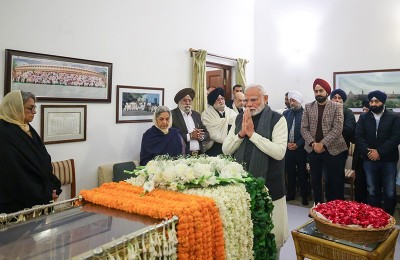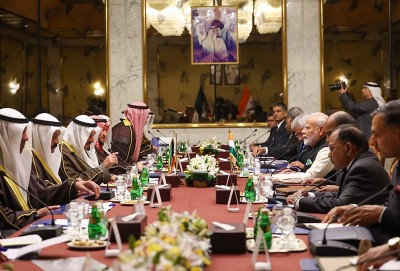
Bolpur: Infant Jesus Church draws inspiration from Tagore's teachings and Santhal culture
Bolpur, Jan 18 (IBNS): Taking a leaf out of the 'inculturation' concept, the new Infant Jesus Church, located in the heart of Bolpur, has drawn inspiration from the Tagorean influence of Shantiniketan and the local Santhal tribes of West Bengal.
The Church, inaugurated on Thursday by Bishop Cyprian Monis from Asansol, has a statue of Jesus imparting his teachings under a banyan tree seated in a lotus position -- a throwback to the open-air classes held in the Viswa Bharati or university started by Rabindranath Tagore, where the teacher sat in a lotus position and addressed the students in front.
The Infant Jesus Church depicts a mixed style of art. Shantiniketan-style motifs, reliefs and art work have used for decoration while Santhal motifs can be seen along the facade of the church .
 Bishop Cyprian Monis said: “As we all know that Shantiniketan has a history of imparting education in a vedic way so we wanted to have a church based on the tradition of Shantiniketan. Here we have added small symbols of tradition like the banyan tree under which Jesus is sitting in a meditating posture. All the installations and murals around the church are based on the tribal tradition and the tradition of Shantiniketan.”
Bishop Cyprian Monis said: “As we all know that Shantiniketan has a history of imparting education in a vedic way so we wanted to have a church based on the tradition of Shantiniketan. Here we have added small symbols of tradition like the banyan tree under which Jesus is sitting in a meditating posture. All the installations and murals around the church are based on the tribal tradition and the tradition of Shantiniketan.”
Driving home the importance of ‘inculturation’, he said: “If Jesus would have born in this culture, he too would have incorporated this culture. Presently all the churches are inculturating the local culture. Churches are open to the cultural heritage to bring in the culture of people into the church so that the don’t feel alienated from their culture,” he added.
The church has been designed by Kolkata-based Church Art, an art & design fabrication firm specializing in incultured church art balancing it with the Canon laws and Christian traditions and conventions.
 “We have incorporated the local traditions of Shantiniketan while trying to integrate the church decor with the artistic style of Kabiguru Rabindranath Tagore and also popular traditions like the open air classrooms which he had started,” said Subrata Ganguly, the founder-director of Church Art.
“We have incorporated the local traditions of Shantiniketan while trying to integrate the church decor with the artistic style of Kabiguru Rabindranath Tagore and also popular traditions like the open air classrooms which he had started,” said Subrata Ganguly, the founder-director of Church Art.
The background of the tabernacle at the recently inaugurated Church is in the shape of a ‘kula’, which is used by locals tribes to thresh food grains, beetle leaf and beetle nut.
The centre-piece in the Church’s sanctuary is an imposing banyan tree under which Jesus is seated in lotus position imparting his teaching and blessings to all.
Above the banyan tree is the depiction of the Spirit of Wisdom and Enlightenment.
On the right side of banyan tree is the tabernacle enshrined in the traditional winnowing fan decorated with bamboo background and surrounded by conch shells.
On the left side of the banyan tree is the Infant Jesus - the patron of the Church.
According to Ganguly, the process of inculturation, is basically the indigenisation of the Church by assimilating local culture and symbols in construction, layout, interior design, furniture and religious fixtures like the tabernacles.
 “Presently there are around 45 churches across India which have been wholly or partially inculturated with Indian architectural forms and motifs. Most of these churches have been designed with murals, panels, furniture, and religious fixtures inspired by Hindu religion,” said Ganguly
“Presently there are around 45 churches across India which have been wholly or partially inculturated with Indian architectural forms and motifs. Most of these churches have been designed with murals, panels, furniture, and religious fixtures inspired by Hindu religion,” said Ganguly
The back wall of the church has a 40-feet mural installation depicting Jesus sitting under a huge banyan tree and holding a child and surrounded by women bringing their children to Jesus for his blessings.
The prevailing art forms have also been incorporated in the stained glasses adorning the church.
“Christian presence and influence has been evident since the birth of Shantiniketan,” said Diocesan Treasurer, Fr. Rahul Sequiera, who reminded the audience how several notable people, who were Christians by faith, lived in Shantiniketan.
Fr. Sequiera recalled, “Tagore had invited to Shantiniketan, Bramhabandav Upadyaya, the founding father of Indian Catholic theology, who spearheaded the Hinduisation of Christianity on the basis of his Thomistic reading of SaccidÄnanda.
Rabindranath Tagore was known to have good relation with people such as Angelo da Fonseca, C F Andrews and others.
Angelo da Fonseca was born in St Estevam (Goa) in 1902 and had studied under Rabindranath Tagore in Kolkata. He was subsequently condemned and expelled from Goa by the Portuguese Colonial Government for painting the Virgin Mary in a traditional Goan sari.
A close friend of both Gandhi and Tagore, Charles Freer Andrews was a priest from Cambridge who taught philosophy at St Stephen's College Delhi and supported India's struggle for freedom. He arrived in Vishwa Bharati in 1914 and worked closely with Tagore to make Vishwa Bharati aglobally acclaimed academic centre. Andrews also travelled widely with the poet in India and abroad. He also translated many of Tagore's works into English.
The Christian mission's presence started with Jesuit missionary Fr. Charles Poncelet visit to Bolpur in the 1950s from Sahebdanga.
From May 1981, the Bolpur Division was looked after by the Salesian Fathers from Joypur, Siuri, after a plot of land was bought at Makrampur by Salesian Fr. Cyriac Manaianchira for developing a center.
In 1993, the Salesian Congregation handed over Bolpur Sub Division to the Archdiocese of Kolkata and Fr. Valerian Fernandes was appointed as the first Priest-in Charge.
In 1995, Fr. Robert D'Souza was appointed Priest-in Charge and in February, 1997, a new community center was blessed by Bishop Cyprian Monis.
On July 4, 1999 it was elevated to a parish and Fr. Robert D'Souza was the first parish priest and he wanted to build a shrine dedicated to the Infant Jesus.
Fr. Dolphy Mathias was appointed as the Parish Priest in 2006, who started the construction of the Church on Jan 15, 2015.
(Reporting by Adit Majumder, Images by Souvik Das/IBNS)
Support Our Journalism
We cannot do without you.. your contribution supports unbiased journalism
IBNS is not driven by any ism- not wokeism, not racism, not skewed secularism, not hyper right-wing or left liberal ideals, nor by any hardline religious beliefs or hyper nationalism. We want to serve you good old objective news, as they are. We do not judge or preach. We let people decide for themselves. We only try to present factual and well-sourced news.







